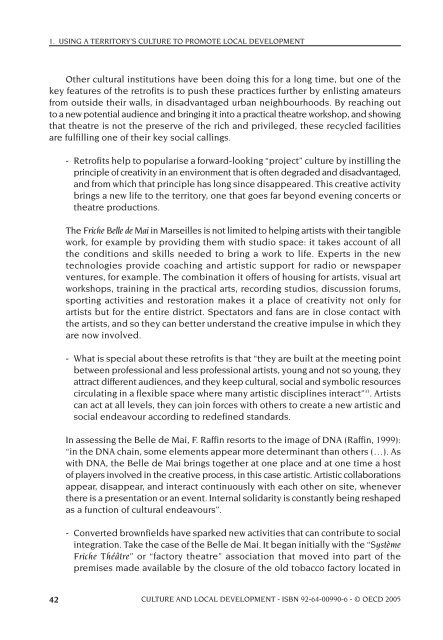OECD Culture and Local Development.pdf - PACA
OECD Culture and Local Development.pdf - PACA
OECD Culture and Local Development.pdf - PACA
You also want an ePaper? Increase the reach of your titles
YUMPU automatically turns print PDFs into web optimized ePapers that Google loves.
1. USING A TERRITORY’S CULTURE TO PROMOTE LOCAL DEVELOPMENT<br />
Other cultural institutions have been doing this for a long time, but one of the<br />
key features of the retrofits is to push these practices further by enlisting amateurs<br />
from outside their walls, in disadvantaged urban neighbourhoods. By reaching out<br />
to a new potential audience <strong>and</strong> bringing it into a practical theatre workshop, <strong>and</strong> showing<br />
that theatre is not the preserve of the rich <strong>and</strong> privileged, these recycled facilities<br />
are fulfilling one of their key social callings.<br />
- Retrofits help to popularise a forward-looking “project” culture by instilling the<br />
principle of creativity in an environment that is often degraded <strong>and</strong> disadvantaged,<br />
<strong>and</strong> from which that principle has long since disappeared. This creative activity<br />
brings a new life to the territory, one that goes far beyond evening concerts or<br />
theatre productions.<br />
The Friche Belle de Mai in Marseilles is not limited to helping artists with their tangible<br />
work, for example by providing them with studio space: it takes account of all<br />
the conditions <strong>and</strong> skills needed to bring a work to life. Experts in the new<br />
technologies provide coaching <strong>and</strong> artistic support for radio or newspaper<br />
ventures, for example. The combination it offers of housing for artists, visual art<br />
workshops, training in the practical arts, recording studios, discussion forums,<br />
sporting activities <strong>and</strong> restoration makes it a place of creativity not only for<br />
artists but for the entire district. Spectators <strong>and</strong> fans are in close contact with<br />
the artists, <strong>and</strong> so they can better underst<strong>and</strong> the creative impulse in which they<br />
are now involved.<br />
- What is special about these retrofits is that “they are built at the meeting point<br />
between professional <strong>and</strong> less professional artists, young <strong>and</strong> not so young, they<br />
attract different audiences, <strong>and</strong> they keep cultural, social <strong>and</strong> symbolic resources<br />
circulating in a flexible space where many artistic disciplines interact” 33 . Artists<br />
can act at all levels, they can join forces with others to create a new artistic <strong>and</strong><br />
social endeavour according to redefined st<strong>and</strong>ards.<br />
In assessing the Belle de Mai, F. Raffin resorts to the image of DNA (Raffin, 1999):<br />
“in the DNA chain, some elements appear more determinant than others (…). As<br />
with DNA, the Belle de Mai brings together at one place <strong>and</strong> at one time a host<br />
of players involved in the creative process, in this case artistic. Artistic collaborations<br />
appear, disappear, <strong>and</strong> interact continuously with each other on site, whenever<br />
there is a presentation or an event. Internal solidarity is constantly being reshaped<br />
as a function of cultural endeavours”.<br />
- Converted brownfields have sparked new activities that can contribute to social<br />
integration. Take the case of the Belle de Mai. It began initially with the “Système<br />
Friche Théâtre” or “factory theatre” association that moved into part of the<br />
premises made available by the closure of the old tobacco factory located in<br />
42 CULTURE AND LOCAL DEVELOPMENT - ISBN 92-64-00990-6 - © <strong>OECD</strong> 2005














